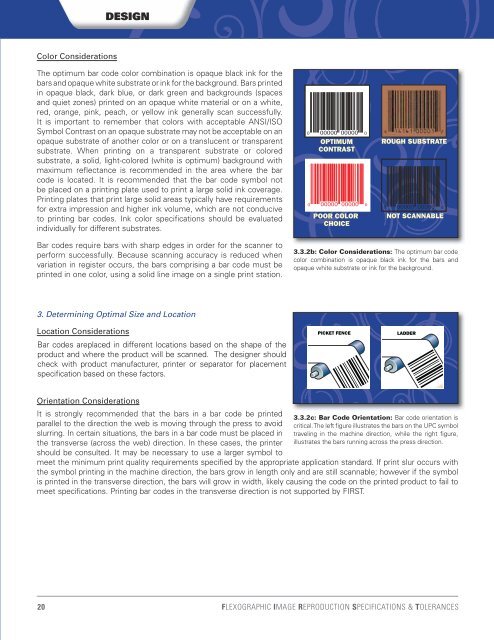First Design Guide - Flexographic Technical Association
First Design Guide - Flexographic Technical Association
First Design Guide - Flexographic Technical Association
You also want an ePaper? Increase the reach of your titles
YUMPU automatically turns print PDFs into web optimized ePapers that Google loves.
Color Considerations<br />
The optimum bar code color combination is opaque black ink for the<br />
bars and opaque white substrate or ink for the background. Bars printed<br />
in opaque black, dark blue, or dark green and backgrounds (spaces<br />
and quiet zones) printed on an opaque white material or on a white,<br />
red, orange, pink, peach, or yellow ink generally scan successfully.<br />
It is important to remember that colors with acceptable ANSI/ISO<br />
Symbol Contrast on an opaque substrate may not be acceptable on an<br />
opaque substrate of another color or on a translucent or transparent<br />
substrate. When printing on a transparent substrate or colored<br />
substrate, a solid, light-colored (white is optimum) background with<br />
maximum reflectance is recommended in the area where the bar<br />
code is located. It is recommended that the bar code symbol not<br />
be placed on a printing plate used to print a large solid ink coverage.<br />
Printing plates that print large solid areas typically have requirements<br />
for extra impression and higher ink volume, which are not conducive<br />
to printing bar codes. Ink color specifications should be evaluated<br />
individually for different substrates.<br />
Bar codes require bars with sharp edges in order for the scanner to<br />
perform successfully. Because scanning accuracy is reduced when<br />
variation in register occurs, the bars comprising a bar code must be<br />
printed in one color, using a solid line image on a single print station.<br />
3. Determining Optimal Size and Location<br />
Location Considerations<br />
Bar codes areplaced in different locations based on the shape of the<br />
product and where the product will be scanned. The designer should<br />
check with product manufacturer, printer or separator for placement<br />
specification based on these factors.<br />
Orientation Considerations<br />
It is strongly recommended that the bars in a bar code be printed<br />
parallel to the direction the web is moving through the press to avoid<br />
slurring. In certain situations, the bars in a bar code must be placed in<br />
the transverse (across the web) direction. In these cases, the printer<br />
should be consulted. It may be necessary to use a larger symbol to<br />
meet the minimum print quality requirements specified by the appropriate application standard. If print slur occurs with<br />
the symbol printing in the machine direction, the bars grow in length only and are still scannable; however if the symbol<br />
is printed in the transverse direction, the bars will grow in width, likely causing the code on the printed product to fail to<br />
meet specifications. Printing bar codes in the transverse direction is not supported by FIRST.<br />
20<br />
DESIGN<br />
DESIGN<br />
3.3.2b: Color Considerations: The optimum bar code<br />
color combination is opaque black ink for the bars and<br />
opaque white substrate or ink for the background.<br />
PICKET FENCE LADDER<br />
3.3.2c: Bar Code Orientation: Bar code orientation is<br />
critical. The left figure illustrates the bars on the UPC symbol<br />
traveling in the machine direction, while the right figure,<br />
illustrates the bars running across the press direction.<br />
FLEXOGRAPHIC IMAGE REPRODUCTION SPECIFICATIONS & TOLERANCES


